Tiguan Grows Longer, Adds Third Seat Option
By John Gilbert
As an SUV-buying society, we haven’t properly appreciated the Volkswagen Tiguan all through its existence. Now that it’s 2019, it’s still not too late, but the boundaries have changed.
For years, the Tiguan, Volkswagen’s compact crossover, was the company’s SUV, even when it wasn’t so much an SUV as a tall station wagon. It was always convenient for hauling a family and gear on trips, across the country or to the mall, or to hockey, soccer, baseball or basketball practice. It was solid, substantial, and performed well for both power, agility and gas mileage.
When the SUV craze not only hit but escalated rapidly out of control, companies that built cars soon realized that if they didn’t also build SUVs, they might soon be marketed right out of existence. I recall when Porsche built its first Cayenne, those of us in the invited automotive media assembled to drive the vehicles on and off a race track and off-road. The question on everybody’s mind finally got asked.
“Why would Porsche, a company that builds the best sports cars on the planet, bother building an SUV?”
The Porsche executive answered without hesitation: “So that we can continue to build the best sports cars on the planet.”
Those words ring true for every manufacture now, and not just because Porsche comes under the Volkswagen corporate umbrella. The other reason is that Porsche buyers also wanted SUVs, and they wanted high-end SUVs and were willing to pay a lot of money for them. The Cayenne gave Porsche buyer/owner types the chance to buy an SUV and stay within the Porsche family.
For Volkswagen itself, Beetles, Golfs, Jettas and Passats remained as good cars, great cars, maybe, but sales were shrinking as buyers were going elsewhere to find and buy SUVs. The SportWagen worked well enough, but more size was wanted, if not needed. So the Tiguan continued as an SUV, and Volkswagen added a couple larger SUVs, including the Atlas.
But a year ago, Volkswagen decided to lengthen the Tiguan. Buyers who liked it also wanted a third-row seat, and to meet the demand, or at least the request, VW lengthened the Tiguan and added a third row seat, which could fold down for added cargo space.
For 2018, Volkswagen sold two Tiguans, the remainder of the shorter model, and the highly promoted longer one. For 2019, the longer one is the only one still being produced. To meet all desires, VW makes the two versions different.
The difference comes with a choice of VW’s 4Motion all-wheel drive or front-wheel drive, and the choice of two rows of seats, seating five, or three rows, seating seven. Typical of German companies, VW tells us which choice we must buy.
If you want all-wheel drive, you can get either two or three rows; if you choose front-wheel drive — for better fuel economy or because of no need for AWD — you can only get three rows of seats. If you want two rows and FWD, you’re out of luck.
It may not be a big issue, because the test vehicle we had came with the colorful R-Line trim that included bright “Saffron” insets in the black leather seats, and we folded the third row down to carry some larger items, and promptly forgot it was even there. So folding it down flat behind the roomy second row is a viable option, and if you wind up as the car-pooling driver, you can pop it up in a flash and use the third row seats.
The Tiguan SEL Premium R-Line test vehicle, with 4Motion, carried a list price of $40,485, including a $595 tag for the third-row seat.
It came with Volkswagen’s tried and trusty 2.0-liter 4-cylinder engine, a jewel of performance that has dual overhead camshafts, direct fuel injection and a turbocharger, produces 184 horsepower and 221 foot-pounds of torque, running through all four wheels with 4Motion, and regulated by an 8-speed automatic transmission.
That is the only powertrain offered in any Tiguan. The vehicle has a towing capacity of 1,500 pounds, which isn’t a lot, but is pretty good for a vehicle that is calculated to be just a bit smaller than what qualifies as a midsize SUV.
With its tall seating position and well-supported comfort, the Tiguan is always pleasant to drive, or to ride in, and just to make my North Shore home on Lake Superior more viable as the perfect road-testing venue, we got a quick and surprising snowstorm that covered and surrounded the Tiguan, but it simply breezed through every challenge.
Well, almost. The greatest challenge was another Volkswagen/German decision made for its owners and drivers. There is a neat little rotating mode switch on the console, and you can turn it to engage different settings for Eco, Normal, Sport, or Custom. Eco gave us front-wheel drive, for most normal driving. After the snowstorm, we simply turned the switch to the setting that incorporated snow driving, as opposed to highway, hills, mud, rocks and off-road, and it went fine.
I noticed my wife, Joan, pulling out one morning and the front wheels spun a bit as she got going in our driveway . I sent her a text message for later reading to say I thought somehow she had switched into front-wheel drive. She responded that I was correct and that she realized quickly that the Tiguan would go to default every time you shut it off, so when you start up again, you’re in FWD, not AWD.
I’m not sure that’s a major issue, but it would make more sense, in Northern Minnesota, for every VW to have AWD as its “Default” setting from November to May. If you start up after a blizzard that is deep enough and on a slippery base, you could get into more trouble than you deserve if you think you’re in AWD but have only FWD.
Because they have made the Tiguan rock-solid for years, driving the new Tiguan gives you a secure feeling of confidence, and the car also handles our other two premier test-driving attractions: Steep hills and enough potholes to meet the requirements of any obstacle course.
Along with the safe build quality, the Tiguan SEL Premium houses adaptive cruise control, park distance control front and rear, remote start, and keyless access, for convenience. Once underway, you also benefit from forward collision warning and autonomous emergency braking and pedestrian detection, active blind spot and rear traffic alerts, lane keeping system with lane assist, high beam control, touchscreen navigation, anti-theft alarm with engine immobilizer, voice-control with touchscreen navigation, all the USB and connectivity receptacles, and a special feature — the Digital Cockpit borrowed from affiliate Audi that can be adjusted to get all sorts of information within the gauges.
The Tiguan has gotten more attractive since being stretched, with a Passat/Jetta style grille and front styling, and its proportions seem to fit the lengthier body style. The longer Tiguan makes the previous one look short and stubby by comparison, and not as elegant.
For the sake of full disclosure, however, I have to say now that the shorter Tiguan is out of production, I really miss that vehicle. Long live the new Tiguan, but thanks to the used car market, the older, shorter Tiguan will still be findable.


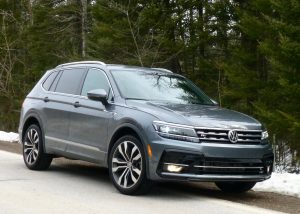
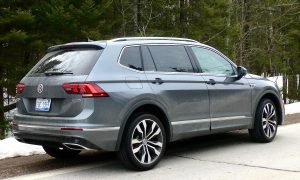
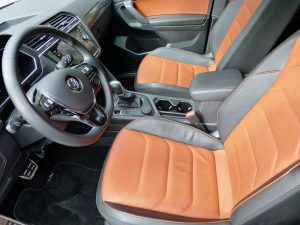
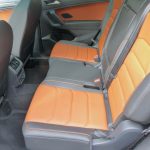
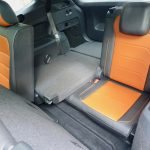
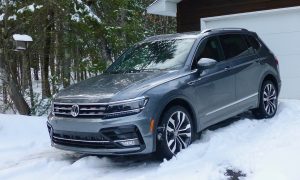
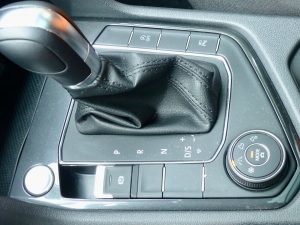
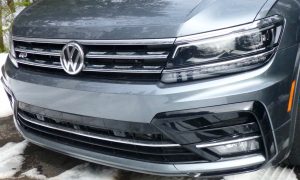
 John Gilbert is a lifetime Minnesotan and career journalist, specializing in cars and sports during and since spending 30 years at the Minneapolis Tribune, now the Star Tribune. More recently, he has continued translating the high-tech world of autos and sharing his passionate insights as a freelance writer/photographer/broadcaster. A member of the prestigious North American Car and Truck of the Year jury since 1993. John can be heard Monday-Friday from 9-11am on 610 KDAL(www.kdal610.com) on the "John Gilbert Show," and writes a column in the Duluth Reader.
John Gilbert is a lifetime Minnesotan and career journalist, specializing in cars and sports during and since spending 30 years at the Minneapolis Tribune, now the Star Tribune. More recently, he has continued translating the high-tech world of autos and sharing his passionate insights as a freelance writer/photographer/broadcaster. A member of the prestigious North American Car and Truck of the Year jury since 1993. John can be heard Monday-Friday from 9-11am on 610 KDAL(www.kdal610.com) on the "John Gilbert Show," and writes a column in the Duluth Reader.